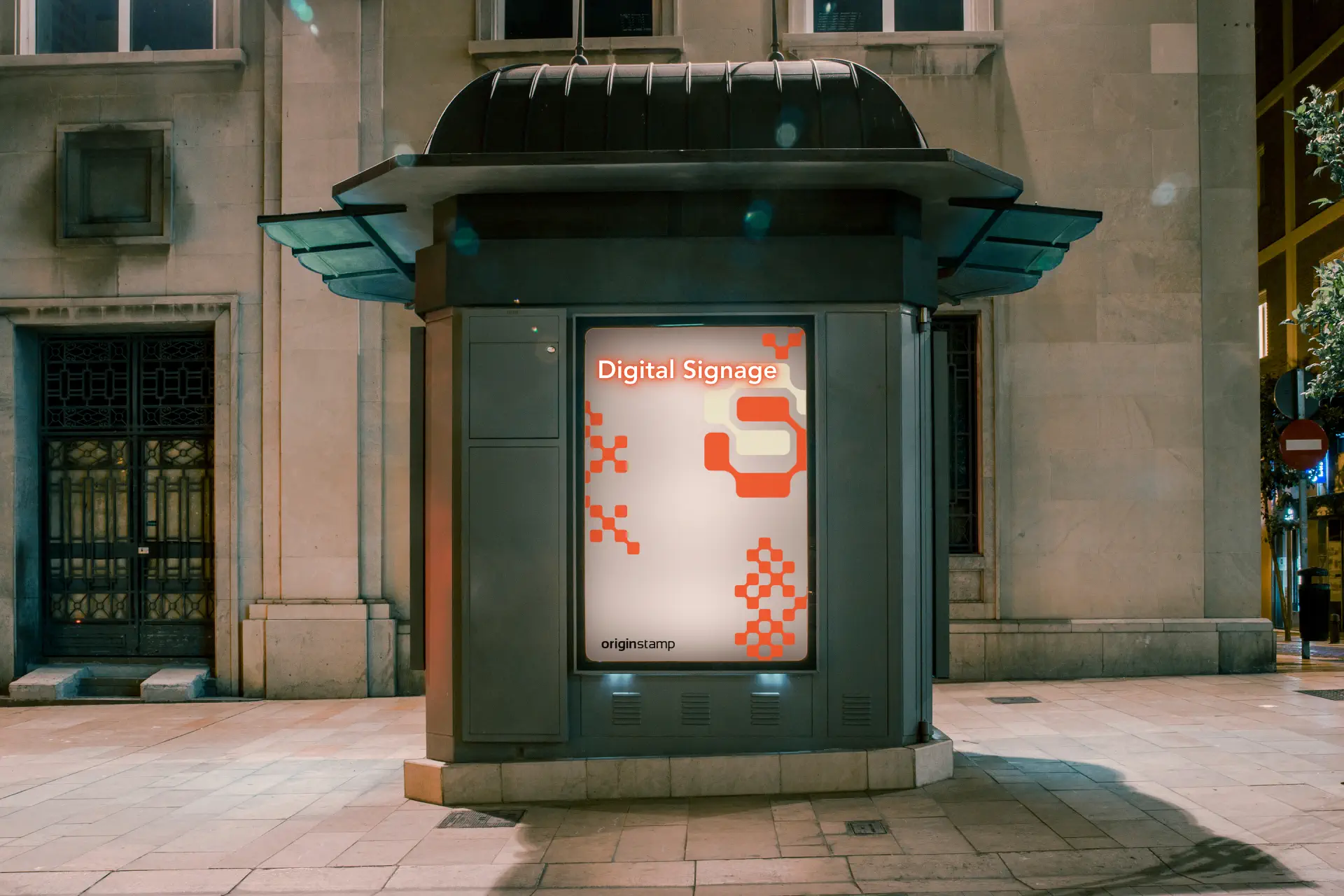
Digital Signage & AI – What Powers the Smart Displays
Patricia Goeft
Thu Jul 03 2025

Table of Contents
- What is Digital Signage?
- The Origin and Evolution of Digital Signage
- How Does Digital Signage Work? Technology & Requirements
- Practical Applications of Digital Signage
- Benefits of Digital Signage
- Artificial Intelligence & Innovations in Digital Signage
- Risks and Challenges of Digital Signage
- Market Leaders & Providers in Digital Signage
- Who Benefits from Digital Signage?
Digital displays that not only inform but fascinate – that’s Digital Signage. And if you still think it’s just about “electronic billboards,” you’ve missed the real revolution.
I spent a weekend in Barcelona. While strolling through the old town, I noticed screens everywhere – in the metro with live info, in boutiques with changing offers, at the beach with weather alerts. Everything felt seamless, up-to-date, and helpful – almost like a conversation with the city itself.
Ever since, I’ve wondered: Why isn’t all information organized this smartly? Welcome to the world of Digital Signage.
What is Digital Signage?
Digital Signage refers to the targeted use of digital screens to display information, advertisements, or interactive content. This technology is now indispensable in modern city centers, shopping malls, train stations, restaurants, educational institutions, and offices. The goal of Digital Signage is to present content in a visually appealing way and often communicate in real time.
Unlike traditional print media, content can be managed dynamically, independently of location, and tailored to specific audiences. This not only increases attention but also the relevance of the messages.
The Origin and Evolution of Digital Signage
The story of Digital Signage began in the 1970s with early electronic displays in airports. Thanks to technological advances – especially in internet, displays, and content management – Digital Signage evolved in the 2000s into a scalable marketing tool for businesses.
Today it’s part of the so-called Phygital Experience: the fusion of physical and digital worlds, particularly in retail, public spaces, and event marketing.
How Does Digital Signage Work? Technology & Requirements
A functioning Digital Signage system consists of three main components:
- Hardware: Displays (LED/LCD), playback devices, sensors, possibly cameras
- Software: A content management system (CMS) for digital screens to plan, control, and distribute content
- Network: Stable internet connection for real-time transmission and centralized control
Additional modules such as touch functionality, AI-driven facial recognition, or weather data integration significantly expand the range of applications.
Practical Applications of Digital Signage
Digital Signage is used in numerous industries:
- Retail: Digital storefronts, product information, attention-grabbing displays near entrances, and interactive touchpoints
- Event Marketing: Digital wayfinding, program overviews, sponsor presentations, interactive feedback terminals
- Gastronomy: Digital menus, promotional notices, order terminals
- Healthcare: Patient call systems, waiting time displays, educational videos
- Educational Institutions: Room schedules, event notices, safety information
- Companies & Offices: Reception displays, visitor guidance, internal real-time communication
- Transport & Logistics: Real-time schedules, safety and guidance systems
Example Retail: In a perfume chain, interactive displays with Augmented Reality (AR) are used to suggest scents based on age, gender, and time of day. Customers can view product reviews or activate a scent tester via touch displays. According to a Shopify analysis, using such technologies leads to a 22% increase in operational efficiency and a 20% faster implementation compared to traditional product displays. These improvements not only increase customer dwell time but also promote sales through a personalized digital product experience.
Example Gastronomy: In a burger chain, large digital displays replace traditional menu boards. They show changing lunch specials, seasonal offers, and integrate with the ordering system via QR code. According to a Techconsult study commissioned by Deutsche Telekom, such digital solutions increase the average order value by up to 15% thanks to improved ordering processes and higher customer satisfaction.
Benefits of Digital Signage
Why is Digital Signage so effective?
- Up-to-date: Content can be adjusted within minutes.
- Relevant: Displays can show different content based on time of day, location, or audience.
- Cost-efficient: Long-term savings on printing, shipping, and manual updates.
- Visual impact: Moving images and animations attract significantly more attention than static posters.
- Measurable: Interactions with digital signage can be tracked with metrics, providing valuable data to optimize content.
- Scalable: Whether a small café or an international hotel chain – Digital Signage can scale from a single system to a global multi-site solution.
Guide: Your Digital Signage Strategy in 5 Steps
A successful Digital Signage strategy follows a clear roadmap. Here’s how to proceed:
Define goals
What do you want to achieve? (e.g. increase brand awareness, boost sales, improve customer service)Analyze target groups
Who should be addressed? (Age, interests, time of day)Develop a content strategy
What content suits the target group and location? (Videos, slideshows, live data, interactive content)Build technical infrastructure
Choose suitable hardware (displays, media players) and software (content management system)Measure success and continuously optimize
Define KPIs (e.g. foot traffic, interaction rates, sales figures)
Regularly update content and adapt based on evaluations
With these clear steps, you can implement your Digital Signage project effectively – and maximize your return on investment.
Marketing Goals with Digital Signage
An effective Digital Signage concept pursues clear goals:
For your Digital Signage strategy to really hit home, you need more than good content. It’s about delivering the right message at the right time in the right place – with a clear plan that aligns visual design, content strategy, and site selection. Swiss companies like echion Communication (Switzerland) AG and Mysignage GmbH offer strategic consulting and implementation solutions.
Artificial Intelligence & Innovations in Digital Signage
AI is fundamentally transforming Digital Signage. Systems recognize audience characteristics, analyze user behavior in real-time, and optimize content automatically.
These examples show the possibilities of AI systems in Digital Signage:
- Weather-based adjustments: If the system detects rain via a weather API, it automatically switches the screen from sunglasses to umbrella ads. This better triggers spontaneous buying impulses.
- Peak-time promotions: In malls or supermarkets, AI activates promotions or fast-checkout notices when visitor numbers spike. This increases both revenue and traffic efficiency.
- Emotion recognition for more targeted content: Using cameras or sensors, the system detects mood (e.g. relaxed, stressed, interested). Based on this, it shows calming content during stress or humorous ads during good moods to strengthen emotional brand connections.
- Augmented (AR) and Virtual Reality (VR): These extend the ability to immerse customers in brand experiences.
Future innovations include voice control, omnichannel integration, and adaptive interaction. AI-powered systems also enable much more dynamic content control that adjusts in real time to audiences and environmental conditions. Sustainable display solutions that reduce energy use and integrate recycled materials are also on the rise.
The combination of Digital Signage and Artificial Intelligence defines the future of personalized communication.
Risks and Challenges of Digital Signage
Despite many advantages, Digital Signage also presents risks.
A key concern is data protection, especially when cameras or sensors collect personal data. Companies must ensure GDPR compliance and transparently inform affected individuals.
Cyberattacks also pose a threat: unsecured networks and content management systems are potential entry points for hackers who could manipulate content or steal data. Source
Moreover, operational costs shouldn't be underestimated. Besides acquiring hardware and software, there are ongoing costs for maintenance, updates, and energy – especially for large-scale installations.
Integrating Digital Signage into existing IT infrastructure also requires solid technical know-how to minimize technical complexity and downtime.
Market Leaders & Providers in Digital Signage
Samsung has been the global market leader in Digital Signage for years with a 28% market share.
Samsung dominates the global Digital Signage market with advanced displays, its own CMS software, and a strong global partner network.
Modern LED and LCD displays from Samsung offer brilliant image quality and are built for 24/7 use. With MagicINFO, Samsung developed its own CMS to centrally manage and update content in real time. A strong global partner network ensures fast support and strengthens customer loyalty.
This consistent combination of innovation, quality, and service makes Samsung the number one in the Digital Signage market.
Providers in Switzerland
- Screenimage AG: Specialized in retail, tourism, transport, and corporate communication
- Friendlyway Schweiz: Part of the international Friendlyway group; specialized in interactive kiosk systems, visitor and wayfinding systems
- i-tech24 GmbH: Specialized in Digital Signage solutions for industry, retail, and healthcare
It’s worth comparing providers in terms of support, CMS functionality, hardware quality, and industry focus.
Who Benefits from Digital Signage?
Anywhere that information should be delivered in a targeted, up-to-date, and attention-grabbing way – whether in retail, gastronomy, or education – Digital Signage is a real gamechanger. With AI and sensors, it becomes a powerful tool that delivers messages precisely and catches your audience’s eye.
Ready to take your communication to the next level?
Use our step-by-step guide to craft your personal Digital Signage strategy!

